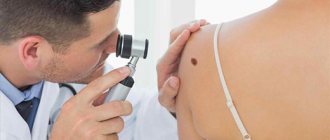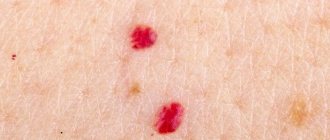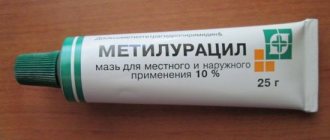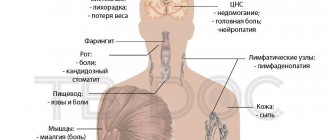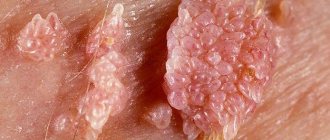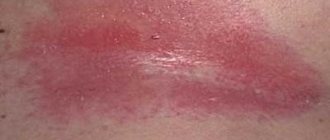Becker's nevus is a benign neoplasm that appears in the upper epithelial layer of the skin of the human body. Nevus cells are covered with hair and are also saturated with dark brown pigment. In medicine, excessive hairiness of a certain part of the skin is called “hypertrichosis.” Becker's nevus may appear at some stage in a person's life or be congenital in origin. Often such neoplasms occur in girls and boys who are entering the puberty phase.
Classification
A mole, or nevus, is a congenital or acquired formation on the skin, which in the vast majority of cases is benign. In dermatology they are classified according to several criteria:
By appearance:
- flat,
- convex,
- warty.
By color:
- brown,
- black,
- purple,
- red,
- white.
By location:
- epidermal,
- interdermal,
- boundary.
Nevi vary in size: from almost invisible to huge birthmarks covering a significant area of the skin. Such giant moles are considered the most dangerous and require close attention .
The coloring of a mole in dark colors occurs due to the pigment - melanin, the amount of which is individual for each person and depends on race, characteristics of the body, as well as on the duration of exposure to sunlight.
Unlike other birthmarks, white moles do not have an excess, but a lack of melanin. Most often they are small round or oval spots located on the skin, singly or in groups. They are not painful and do not cause problems for a person. It happens that white nevi on the face or body decrease over time and disappear without a trace. There are also transparent, almost colorless, moles that are difficult to notice on the surface of the skin.
What does a mole on the neck mean for men and women?
Moles have always attracted the attention of others; in the old days, such formations were considered the mark of the devil, and the owner was burned at the stake. In modern society, such an event is no longer approved. But nevi continue to be assigned symbolic meaning.
A mole on the right side of a man’s neck indicates a person’s inclination towards leadership. Holders of these marks achieve great success in military service, the army and political activities. On the left, a growth on the neck indicates great willpower. Such a person is able to move mountains to achieve his goals. On the back of the neck, a nevus symbolizes dedication and efficiency; the owner of the mark is used to giving 100% in any task. A new growth in the middle of the throat is a sign of good luck; such a person will always find a way out of even the most confusing and deplorable situation.
In women, a nevus on the left side of the neck is a symbol of fertility, and on the right it speaks of a desire for adventure and adventurism. If it touches the chin on the side or front, the woman has good intuition and even superpowers.
No matter where the mark is located, remember - it cannot prophesy or change fate. The symbolic meaning can amuse or enhance self-esteem. It pays to be prudent. If your education is growing, go to the doctor, and don’t be happy that your finances will soon increase.
Locations
A small child may have white moles from birth or appear in the first months of life. This is the result of a violation of pigment metabolism that occurs during the prenatal period. As the baby grows, the spots increase in size, which is absolutely normal and does not pose a danger.
Often moles appear in adolescents during hormonal changes in the body. This is considered normal and should not be a cause for concern.
In appearance, a convex white mole resembles a wart. Distinctive features also include:
- smooth and clearly defined boundaries,
- no inflammation around the edges,
- soft surface.
The size of a light or white nevus varies from 2-3 mm to 2-2.5 cm. Most often they are located on the following areas of the body:
- neck,
- armpits,
- shoulders,
- breast,
- external genitalia,
- stomach,
- arms and legs.
Sometimes in adulthood, patients experience the appearance of white spots on the face, limbs, scalp, and groin area. This is a symptom of vitiligo, a skin disease accompanied by the destruction of melanin.
Causes
Insufficient pigment production leads to the appearance of white formations or lightening of dark ones..
The main reasons for this are considered:
- Prolonged exposure to the scorching rays of the sun.
- Frequent visits to the solarium.
- Hormonal changes in the body.
- Taking medications containing corticosteroids.
- Inflammatory processes on the skin (acne, rash).
- Nervous overload, stress.
- Ecological situation.
- Bad habits: alcohol abuse, smoking.
The tendency to form moles is inherited. Moreover, this can manifest itself not only in childhood, but also in fairly mature age.
Safe removal of hair from a mole
When you decide to improve your beauty yourself, you should pay attention to the following points:
- Before cutting, scissors must be disinfected;
- Do not use tweezers to remove hair, as this can injure the mole and cause inflammation;
- Do not remove hair from the nevus by shaving;
- If it was nevertheless damaged (scratched, cut, burned), then it is necessary to disinfect it and stop the bleeding. And - go to see a doctor. The chances of such a mole regenerating are too high. Don't risk your life!
In esotericism they try to explain in their own way the appearance of hairy moles and their meaning. There are also many folk signs and superstitions regarding the appearance of vegetation on the nevus. You don’t have to believe in it, blindly follow all the rituals and dubious methods to get rid of warts, hair, moles...
To avoid harming yourself, it is better to remove moles in a medical facility, rather than in person by watching a master class on the Internet. Health and life are in your hands. The main thing is to make the right choice!
Check moles - step-by-step instructions on how to independently check moles for cancer. Expert advice and overview of typical situations (120 photos and videos)
Types of moles: benign, malignant moles, their characteristics and definition. 115 photos and videos of different types of moles
Black mole: causes of appearance, development and danger of moles. How to detect melanoma at an early stage? (95 photos and videos)
Complications and possible consequences
Birthmarks are not a disease, but a skin defect, which for many people becomes a “highlight” of appearance. And white color is not a pathology, but only an individual characteristic of an organism that produces an insufficient amount of pigment. It would seem that there is no reason to worry about moles on the body. Unfortunately, this is not always true.
The biggest danger that can happen to nevi is degeneration from benign to malignant. Therefore, every person needs to pay attention to birthmarks more often and go to the doctor at the slightest changes.
The following symptoms should be cause for concern:
- the flat formation became convex,
- a white dot that appears on a dark mole,
- a white halo forms around the nevus,
- the mole begins to hurt and itch,
- bleeding,
- violation of clear boundaries, growth of the birthmark.
If formations of a different color begin to appear next to the white mole or the nevus itself begins to change color, you should immediately make an appointment with a specialist. This especially applies to people over 60 years of age, people who have more than a dozen tumors on their body, especially large and very large ones.
Of particular danger are white moles located in places where they are constantly injured by clothing. If there is a violation of integrity and bleeding, the likelihood of the nevus degenerating into oncology increases several times.
Stages of development
Like any other third-party neoplasm of epithelial cells, Becker’s nevus has its own developmental feature, which in dermatology today is divided into the following stages:
- Melanin concentration. This is the first stage of birthmark formation, when the epidermal tissues just begin to accumulate coloring pigment. The first outlines of future education are appearing. The affected area of the skin on the general surface of the body is distinguished by a rich dark brown color.
- Enlargement of lesions. The location of Becker's nevus actively begins to fill with melanin, and the spot itself increases in circumference. Against this background, the hormonal levels in the human body change dramatically, which only contributes to the appearance of a benign neoplasm.
- Completing the contour outline. At this stage, it is already possible to determine the clear boundaries of the future formation, which most often have an irregular shape and look like an elongated oval.
- Consolidation of the epithelium. The skin, which has undergone excessive pigmentation, begins to become dense, its surface acquires an uneven and bumpy structure. If before this this area of the epithelium was subject to viral or bacterial invasion, then the presence of purulent pustules or acne cannot be ruled out.
- Hair growth. This is the final stage of nevus formation as a benign independent neoplasm. The mole is completely overgrown from the center to the edges with black thick hair that resembles a hard brush to the touch. This hair structure is explained by an excessive amount of male sex hormones in the epithelial tissues of the problem skin area.
Diagnostics
Diagnosis and treatment of skin diseases is carried out by dermatologists and cosmetologists in specialized clinics. An external examination of the birthmark is carried out to determine its location, size, shape, and color. Then the doctor interviews the patient, finding out hereditary predisposition, living conditions, and the presence of provoking factors.
To make a correct diagnosis, the following procedures may be necessary:
- examination using a dermatoscope,
- taking smears from the surface of the nevus,
- blood test for tumor markers,
- CT scan.
Differential diagnosis is necessary to separate the nevus from other formations on the skin - warts, molluscum contagiosum, basal cell carcinoma. After removal of a mole, it is sent for histological examination and biopsy to ensure its benignity or to determine signs of degeneration.
Diagnostic measures
Usually, Becker's nevus can be easily distinguished from other pathologies due to hypertrichosis and its large size, but in certain cases, diagnosis is difficult due to its similarity to other types of moles. For example, a skin neoplasm of Becker-Reitar in the initial stages can be confused with a giant melanocytic nevus, but this type is most often congenital. Similar symptoms are also observed during the onset of nevus of Ota and Albright-McCune-Steinberg syndrome.
A more accurate diagnosis can be made by an experienced oncologist or dermatologist during a consultation, during which the doctor will conduct an initial examination and determine clinical symptoms based on an oral interview. If the doctor has doubts, he may prescribe hardware examination methods - skiascopy and dermatoscopy. In the latter case, the study is carried out using a device that magnifies the spot many times and makes it possible to examine the deeper layers of the skin.
During skiascopy, the area is viewed using a special scanner, which allows you to study the developmental features and structure of the nevus. If even after this the diagnosis is not established, then as a last resort a biopsy is prescribed - collection of tumor material for further laboratory examination.
Treatment method
If white birthmarks are located in inconspicuous places, do not bother a person and do not have a tendency to develop into malignant ones, then there is no need to carry out any therapeutic measures.
If a mole causes discomfort or can lead to undesirable consequences, it is necessary to get rid of it.
Therapeutic methods
Drug treatment of moles with therapeutic methods can neither remove them nor stop their growth. Therefore, to remove nevi, they resort to drastic methods - surgical or minimally invasive .
Minimally invasive methods are usually painless and do not require anesthesia. In some cases, at the request of the patient, local anesthesia is given. All procedures do not require a hospital setting, but are performed on an outpatient basis; upon completion, the patient goes home.
The most popular methods for removing skin tumors are the following:
- Electrocoagulation. The mole is removed with an “electronic knife” using high-frequency currents. After the procedure, a scar or pigmented spot may remain on the skin.
- Cryodestruction. Exposure of the nevus to liquid nitrogen, after which the formations die and peel off layer by layer. If the mole is deep in the skin, a repeat procedure may be necessary.
- Radiosurgery. Birthmarks are removed using a beam of directed radio waves (radio knife). The method is used for small formations and only with 100% confidence in their good quality.
- Laser photocoagulation. The tumor is removed layer by layer with a laser beam. At the same time, coagulation of blood vessels occurs, preventing bleeding. The method is considered the most effective and takes no more than 15 minutes.
If a mole is suspected of degenerating or in cases where the use of minimally invasive methods is impossible for any reason, removal is carried out using the traditional surgical method.
In this case, a small area of skin is cut out along with the tumor, and sutures are placed on the wound. The operation is performed under local anesthesia. At first, you may experience pain and a feeling of tightness, which goes away after a few days. After surgery, a scar remains on the skin.
Traditional medicine methods
Many traditional healers suggest getting rid of white moles using medicinal herbs and other home remedies. Before taking their advice, you need to make sure that the formation is benign and does not have a tendency to degenerate. To do this, you need to go to a specialized clinic and undergo a full examination.
If there are no contraindications for traditional medicine, then you can use the following recipes:
- Mix a teaspoon of honey and a teaspoon of flaxseed oil. Apply to the mole 3 times a day.
- Grind 3 cloves of garlic, add 1 tablespoon of freshly squeezed lemon juice. Gently rub the mixture into the mole several times a day.
- White nevus can be rubbed with a fresh piece of pineapple or a slice of lime.
- Pluck the celandine grass and squeeze the juice from the stem. Apply to the formation 2-3 times a day.
- Combine a tablespoon of apple cider vinegar with a teaspoon of castor oil. Apply the mixture to the mole as a compress at night for 10 days.
It is not recommended to burn moles with vinegar essence or other chemicals at home. This can lead to damage to the skin, entry of pathogens and inflammation.

